Development of Vulnerability Assessment Framework for Disaster Risk Reduction at Three Levels of Geopolitical Units in the Philippines
Abstract
1. Introduction
2. Materials and Methods
2.1. The Study Area
2.2. The Vulnerability Assessment
2.2.1. Phase 1—Problem Formulation
2.2.2. Phase 2—The Conceptual Model
2.2.3. Phase 3—Vulnerability Characterization
Exposure Indicators
Sensitivity Indicators
Resiliency Indicators
2.2.4. Phase 4—Data Assessment and Validation
2.2.5. Phase 5—Weights Determination
- Nij = the normalized value of indicator i of household j in the case of the household vulnerability analysis;
- Xij = the original value of indicator i of household j in the case of the household vulnerability analysis;
- Ximin = the lowest value among all households;
- Ximax = the highest value among all households.
3. Results
3.1. The Expanded Vulnerability Assessment Model
3.2. The Vulnerability Frameworks
3.3. Data and Characterization of Indicators
3.3.1. The Exposure Indicators
3.3.2. The Sensitivity Indicators
3.3.3. The Resiliency Indicators
3.4. Weight Factor Distribution
3.5. Disaster Management in the Philippines
3.6. The Use of Local Vulnerability Indices
3.7. The Role of the Household and the Government in Reducing Vulnerability
4. Conclusions and Proposals
Author Contributions
Funding
Acknowledgments
Conflicts of Interest
References
- Kreft, S.; Eckstein, D.; Melchior, I. Global Climate Index; Germanwatch: Berlin, Germany, 2017. [Google Scholar]
- Eckstein, D.; Kunzel, V.; Schafer, L. Global Climate Index; Germanwatch: Berlin, Germany, 2018. [Google Scholar]
- United Nations University—Institute for Environment and Human Security. Measuring Vulnerability to Natural Hazards: Towards Disaster Resilient Societies, 2nd ed.; United Nations University Press: New York, NY, USA, 2013. [Google Scholar]
- National Disaster Risk Reduction and Management Council. Major Natural Extreme Events and Disasters 2008 to 2017; National Disaster Risk Reduction and Management Council: Quezon City, Philippines, 2017.
- Kasperson, R.E.; Gow, K. Vulnerable Peoples and Places. In Ecosystems and Human Well-Being: Current State and Trends; Norgaard, R., Rapport, D., Eds.; Island Press: Washington, DC, USA, 2005; pp. 143–164. [Google Scholar]
- O’Brien, K.; Eriksen, S.; Schjolen, A.; Nygaard, L. What’s in a Word? Conflicting Interpretations of Vulnerability in Climate Change Research; CICERO Working Paper 2004:04; CICERO, Oslo University: Oslo, Norway, 2004. [Google Scholar]
- Gow, G.A. Policymaking for Critical Infrastructure—A Case Study on Strategic Interventions in Public Safety Telecommunications; Ashgate Publishing: Farnham, UK, 2005. [Google Scholar]
- Nguyen, K.-A.; Liou, Y.-A.; Terry, J.P. Vulnerability of Vietnam to typhoons: A spatial assessment based on hazards, exposure and adaptive capacity. Sci. Total Environ. 2019, 682, 31–46. [Google Scholar] [CrossRef] [PubMed]
- Füssel, H.-M. Vulnerability: A generally applicable conceptual framework for climate change research. Glob. Environ. Chang. 2007, 17, 155–167. [Google Scholar] [CrossRef]
- Downing, T.E.; Patwardhan, A. Assessing vulnerability for climate adaptation. In Adaptation Policy Frameworks for Climate Change: Developing Strategies, Policies, and Measures; Lim, B., Spanger-Siegried, E., Eds.; Cambridge University Press: Cambridge, UK, 2004; Chapter 3. [Google Scholar]
- United Nations. Living with Risk: A Global Review of Disaster Reduction Initiatives; United Nations International Strategy for Disaster Reduction: Geneva, Switzerland, 2004. [Google Scholar]
- Moss, R.H.; Malone, E.L.; Brenkert, A.L. Vulnerability to Climate Change: A Quantitative Approach; Joint Global Change Research Institute: College Park, MD, USA, 2001. [Google Scholar]
- Cutter, S.; Emrich, C.; Webb, J.; Morath, D. Social Vulnerability to Climate Variability Hazards: A Review of the Literature. Final. Rep. Oxfam Am. 2009, 5, 1–44. [Google Scholar]
- Kaly, U.; Briguglio, L.; Mcleod, H.; Schmall, S.; Pratt, C.; Pal, R. Environmental Vulnerability Index (EVI) to Summarize National Environmental Vulnerability Profiles; SOPAC Technical Report 275; South Pacific Applied Geoscience Commission: Suva, Fiji, 1999. [Google Scholar]
- South Pacific Applied Geoscience Commission (SOPAC) and United Nations Environment Programme. Building Resilience in SIDS: The Environmental Vulnerability; South Pacific Applied Geoscience Commission: Suva, Fiji, 2005. [Google Scholar]
- Esty, D.C.; Levy, M.; Srebotnjak, T.; de Sherbinin, A. 2005 Environmental Sustainability Index: Benchmarking National Environmental Stewardship; Yale Center for Environmental Law and Policy: New Haven, CT, USA, 2005. [Google Scholar]
- Cardona, O.D. Indicators of Disaster Risk and Risk Management: Summary Report; Inter-American Development Bank: Washington, DC, USA, 2008. [Google Scholar]
- Garcia, A.P.; Mateos, P.; Giralt, C.H. A theoretical and methodological essay on the concept of vulnerability. Sociology 2018, 13, 109–122. [Google Scholar]
- Campos-Vargas, M.; Toscana-Aparicio, A.; Campos-Alanís, J. Riesgos socionaturales: Vulnerabilidad socioeconómica, justicia ambiental y justicia espacial. Cuadernos de Geografía: Revista Colombiana de Geografía 2015, 24, 53–69. [Google Scholar] [CrossRef]
- Cuadernos de Geografía: Revista Colombiana de Geografía. Cuadernos de Geografía: Revista Colombiana de Geografía 2014, 24, 53–69. [CrossRef]
- Mateos, P. La doble segregación urbana: Desigualdades socio-espaciales y justicia ambiental. In Proceedings of the Actas del III Congreso Internacional de Desarrollo Local, Universidad de La Habana, Havana, Cuba, 6–9 December 2013; pp. 3488–3510. [Google Scholar]
- Landrigan, P.J.; Rauh, V.A.; Galvez, M.P. Environmental justice and the health of children. Mt. Sinai J. Med. A J. Transl. Pers. Med. 2010, 77, 178–187. [Google Scholar] [CrossRef]
- Moreno-Jiménez, A.; Cañada-Torrecilla, R.; Vidal-Domínguez, M.J.; Palacios-García, A.; Martínez-Suárez, P. Assessing environmental justice through potential exposure to air pollution: A socio-spatial analysis in Madrid and Barcelona, Spain. Geoforum 2016, 69, 117–131. [Google Scholar] [CrossRef]
- Intergovernmental Panel on Climate Change. Climate Change 2001: Synthesis Report. A Contribution of Working Groups I, II, and III to the Third Assessment Report of the Intergovernmental Panel on Climate Change; Watson, R.T., the Core Writing Team, Eds.; Cambridge University Press: Cambridge, UK; New York, NY, USA, 2001; p. 398. [Google Scholar]
- McCarthy, J.J.; Canziani, O.F.; Leary, N.A.; Dokken, D.J.; White, K.S. (Eds.) Climate Change 2001: Impacts, Adaptation, and Vulnerability; Cambridge University Press: Cambridge, UK, 2001. [Google Scholar]
- Karunarathne, A.Y.; Lee, G. Developing a multi-facet social vulnerability measure for flood disasters at the micro-level assessment. Int. J. Disaster Risk Reduct. 2020, 49, 101679. [Google Scholar] [CrossRef]
- Smit, B.; Pilifosova, O.; Burton, I.; Challenger, B.; Huq, S.; Klein, R.J.T.; Yohe, G. Adaptation to climate change in the context of sustainable development and equity. In Climate Change 2001: Impacts, Adaptation and Vulnerability. Contribution of the Working Group II to the Third Assessment Report of the Intergovernmental Panel on Climate Change; McCarthy, J.J., Canziani, O., Leary, N.A., Dokken, D.J., White, K.S., Eds.; Cambridge University Press: Cambridge, UK, 2001; pp. 877–912. [Google Scholar]
- Nguyen, A.K.; Liou, Y.-A.; Li, M.-H.; Tran, T.A. Zoning eco-environmental vulnerability for environmental management and protection. Ecol. Indic. 2016, 69, 100–117. [Google Scholar] [CrossRef]
- Liou, Y.-A.; Nguyen, A.K.; Li, M.-H. Assessing spatiotemporal eco-environmental vulnerability by Landsat data. Ecol. Indic. 2017, 80, 52–65. [Google Scholar] [CrossRef]
- Kitano, H. Systems Biology: A Brief Overview. Science 2002, 295, 1662–1664. [Google Scholar] [CrossRef] [PubMed]
- Berkes, F.; Colding, J.; Folke, C. (Eds.) Navigating Social Ecological Systems: Building Resilience for Complexity and Change; Cambridge University Press: Cambridge, UK, 2003. [Google Scholar]
- Turner, A.L., II; Kasperson, R.E.; Matson, P.A.; McCarthy, J.J.; Corell, R.W.; Christensen, L.; Eckley, N.; Kasperson, J.X.; Luers, A.; Martello, M.L.; et al. A framework for vulnerability analysis in sustainability science. Proc. Natl. Acad. Sci. USA 2003, 100, 8074–8079. [Google Scholar] [CrossRef] [PubMed]
- Adger, W.N. Vulnerability. Glob. Environ. Chang. 2006, 16, 268–281. [Google Scholar] [CrossRef]
- United Nations University. 2016 Annual Report; UNU Centre: Tokyo, Japan, 2016. [Google Scholar]
- Republic Act No. 7160. An Act Providing the Local Government Code of 1991. Eight Congress, Congress of the Philippines: Metro Manila, Philippines, 1991. Available online: https://www.lawphil.net/statutes/repacts/ra1991/ra_7160_1991.html (accessed on 23 October 2020).
- Toda, L.; Orduna, J.R.; Lasco, R.; Santos, C.T. Assessing and mapping barangay level social vulnerability of Tacloban City and Ormoc City to climate-related hazards. Clim. Disaster Dev. J. 2015, 1, 25–40. [Google Scholar] [CrossRef]
- Evariste, F.F.; Jean, S.D.; Victor, K. Assessing climate change vulnerability and local adaptation strategies in adjacent communities of the Kribi-Ocampo coastal ecosystems, South Cameroon. Urban Clim. 2018, 24, 1037–1051. [Google Scholar] [CrossRef]
- Solín, Ľ.; Madajová, M.S.; Michaleje, L. Vulnerability assessment of households and its possible reflection in flood risk management: The case of the upper Myjava basin, Slovakia. Int. J. Disaster Risk Reduct. 2018, 28, 640–652. [Google Scholar] [CrossRef]
- Ado, A.M.; Leshan, J.; Savadogo, P.; Koivogui, S.K.; Pesha, J.C. Households vulnerability to climate change: Insights from a Farming Community in Aguie District of Niger. J. Environ. Earth Sci. 2018, 8, 3. [Google Scholar]
- Ignacio, J.A.F.; Cruz, G.T.; Nardi, F.; Henry, S. Assessing the effectiveness of a social vulnerability index in predicting heterogeneity in the impacts of natural hazards: A case study of the Tropical Storm Washi flood in the Philippines. Vienna Yearb. Popul. Res. Jan. 2015, 13, 91–129. [Google Scholar]
- Balica, S.F.; Wright, N.G.; Van Der Meulen, F. A flood vulnerability index for coastal cities and its use in assessing climate change impacts. Nat. Hazards 2012, 64, 73–105. [Google Scholar] [CrossRef]
- Jha, S.; Martinez, J.A.; Quising, P.; Ardaniel, Z.; Wang, L. Natural Disasters, Public Spending, and Creative Destruction: A Case Study of the Philippines. SSRN Electron. J. 2018. [Google Scholar] [CrossRef]
- Ahamed, M. Community based Approach for Reducing Vulnerability to Natural Hazards (Cyclone, Storm Surges) in Coastal Belt of Bangladesh. Procedia Environ. Sci. 2013, 17, 361–371. [Google Scholar] [CrossRef]
- De Andrade, M.M.N.; Szlafsztein, C.F. Vulnerability assessment including tangible and intangible components in the index composition: An Amazon case study of flooding and flash flooding. Sci. Total Environ. 2018, 630, 903–912. [Google Scholar] [CrossRef] [PubMed]
- Chen, S.; Zha, X.; Bai, Y.; Wang, L. Evaluation of soil erosion vulnerability on the basis of exposure, sensitivity, and adaptive capacity: A case study in the Zhuxi watershed, Changting, Fujian Province, Southern China. Catena 2019, 177, 57–69. [Google Scholar] [CrossRef]
- Cong, P.T.; Manh, D.H.; Huy, H.A.; Phuong, T.T.L.; Tuyen, L.T. Livelihood Vulnerability Assessment to Climate Change at Community Level Using Household Survey: A Case Study from Nam Dinh Province, Vietnam. Mediterr. J. Soc. Sci. 2016, 7, 358. [Google Scholar] [CrossRef]
- Debortoli, N.S.; Camarinha, P.I.M.; Marengo, J.A.; Rodrigues, R.R. An index of Brazil’s vulnerability to expected increases in natural flash flooding and landslide disasters in the context of climate change. Nat. Hazards 2017, 86, 557–582. [Google Scholar] [CrossRef]
- Duan, M.; Gao, Q.; Wan, Y.; Li, Y.; Guo, Y.; Ganzhu, Z.; Wu, Y. Assessing vulnerability and adaptation responses to rain-fall related landslides in China, a case study of Enshi Prefecture in Hubei province. Procedia Environ. Sci. 2011, 11, 1379–1385. [Google Scholar] [CrossRef][Green Version]
- Fernandez, P.; Mourato, S.; Moreira, M.; Pereira, L.G. A new approach for computing a flood vulnerability index using cluster analysis. Phys. Chem. Earth Parts A/B/C 2016, 94, 47–55. [Google Scholar] [CrossRef]
- Liu, X.; Wang, Y.; Peng, J.; Braimoh, A.K.; Yin, H. Assessing vulnerability to drought based on exposure, sensitivity and adaptive capacity: A case study in middle Inner Mongolia of China. Chin. Geogr. Sci. 2012, 23, 13–25. [Google Scholar] [CrossRef]
- Michellier, C.; Kervyn, M.; Barette, F.; Syavulisembo, A.M.; Kimanuka, C.; Mataboro, S.K.; Hage, F.; Wolff, E.; Kervyn, F.; Michellier, C.; et al. Evaluating population vulnerability to volcanic risk in a data scarcity context: The case of Goma city, Virunga volcanic province (DRCongo). Int. J. Disaster Risk Reduct. 2020, 45, 101460. [Google Scholar] [CrossRef]
- Murthy, C.S.; Laxman, B.; Sai, M.V.R.S. Geospatial analysis of agricultural drought vulnerability using a composite index based on exposure, sensitivity and adaptive capacity. Int. J. Disaster Risk Reduct. 2015, 12, 163–171. [Google Scholar] [CrossRef]
- Mwangi, K.K.; Mutua, F. Modeling Kenya’s Vulnerability to Climate Change—A Multifactor Approach. Int. J. Sci. Res. 2015, 3, 9. [Google Scholar]
- Omerkhil, N.; Chand, T.; Valente, D.; Alatalo, J.M.; Alatalo, J.M. Climate change vulnerability and adaptation strategies for smallholder farmers in Yangi Qala District, Takhar, Afghanistan. Ecol. Indic. 2020, 110, 105863. [Google Scholar] [CrossRef]
- Ortega, J.; Vasconcelos, G.; Rodrigues, H.; Correia, M.; Ferreira, T.M.; Vicente, R. Use of post-earthquake damage data to calibrate, validate and compare two seismic vulnerability assessment methods for vernacular architecture. Int. J. Disaster Risk Reduct. 2019, 39, 101242. [Google Scholar] [CrossRef]
- Weis, S.W.M.; Agostini, V.N.; Roth, L.M.; Gilmer, B.; Schill, S.R.; Knowles, J.E.; Blyther, R. Assessing vulnerability: An integrated approach for mapping adaptive capacity, sensitivity, and exposure. Clim. Chang. 2016, 136, 615–629. [Google Scholar] [CrossRef]
- Yang, W.; Xu, K.; Lian, J.; Bin, L.; Ma, C. Multiple flood vulnerability assessment approach based on fuzzy comprehensive evaluation method and coordinated development degree model. J. Environ. Manag. 2018, 213, 440–450. [Google Scholar] [CrossRef]
- Yusuf, A.A.; Francisco, H.A. Climate Change Mapping for Southeast Asia; Economy and Environment Program for Southeast Asia (EEPSEA): Singapore, 2009. [Google Scholar]
- Zhang, S.; Li, C.; Zhang, L.; Peng, M.; Zhan, L.; Xu, Q. Quantification of human vulnerability to earthquake-induced landslides using Bayesian network. Eng. Geol. 2020, 265, 105436. [Google Scholar] [CrossRef]
- Zhang, W.; Xu, X.; Chen, X. Social vulnerability assessment of earthquake disaster based on the catastrophe progression method: A Sichuan Province case study. Int. J. Disaster Risk Reduct. 2017, 24, 361–372. [Google Scholar] [CrossRef]
- Holden, W.N. Mining amid typhoons: Large-scale mining and typhoon vulnerability in the Philippines. Extr. Ind. Soc. 2015, 2, 445–461. [Google Scholar] [CrossRef]
- PEP-Asia CBMS Network Office. Climate Change Vulnerability Mapping in the Philippines: A Pilot Study; Angelo King Institute for Economic and Business Studies (AKI), De La Salle University: Manila, Philippines, 2007. [Google Scholar]
- Atienza, M. Local governments and devolution in the Philippines. In Philippine Politics and Governance: An Introduction; University of the Philippines: Manila, Philippines, 2006. [Google Scholar]
- Legaspi, P. The Changing Role of Local Government under a Decentralized State: The Case of the Philippines. Public Manag. Rev. 2013, 3, 131–139. [Google Scholar] [CrossRef]
- Balce, G.R.; Ramos, E.G. Geologic Hazards in the Philippines; A Definition and an Overview. Saf. Reliab. 1988, 8, 31–46. [Google Scholar] [CrossRef]
- Deressa, T.T.; Hassan, R.M.; Ringler, C. Assessing Household Vulnerability to Climate Change: The Case of Farmers in the Nile Basin of Ethiopia; International Food Policy Research Institute: Washington, DC, USA, 2009. [Google Scholar]
- Rothenberger, B. Disaster Risk Reduction and Management in the Philippines: A desk Study Conducted by the Swiss NGO DRR Platform; Global Risk Forum: Davos, Switzerland, 2014. [Google Scholar]
- Reyes, P.J.D.; Bornas, M.A.V.; Dominey-Howes, D.; Pidlaoan, A.C.; Magill, C.R.; Solidum, J.R.U.; Solidum, R.U. A synthesis and review of historical eruptions at Taal Volcano, Southern Luzon, Philippines. Earth-Sci. Rev. 2018, 177, 565–588. [Google Scholar] [CrossRef]
- Atienza, M.E.; Eadie, P.; Tan-Mullins, M. Urban Poverty in the Wake of Environmental Disaster: Rehabilitation, Resilience and Typhoon Haiyan (Yolanda); Routledge: New York, NY, USA, 2019. [Google Scholar]
- Hallegatte, S.; Bangalore, M.; Vogt-Schilb, A.; Rozenberg, J. Unbreakable: Building the resilience of the poor in the face of natural disasters. In Climate Change and Development Series; International Bank for Reconstruction and Development, The World Bank Group: Washington, DC, USA, 2016. [Google Scholar]
- Bolletinno, V.; Alcayna, T.; Enriquez, K.; Vinck, P. Perceptions of Disaster Resilience and Preparedness in the Philippines; Harvard Humanitarian Initiative, Harvard University: Cambridge, MA, USA, 2018. [Google Scholar]
- Belhadj, B. New weighting scheme for the dimensions in multidimensional poverty indices. Econ. Lett. 2012, 116, 304–307. [Google Scholar] [CrossRef]
- Decancq, K.; Lugo, M.A. Weights in Multidimensional Indices of Wellbeing: An Overview. Econ. Rev. 2013, 32, 7–34. [Google Scholar] [CrossRef]
- Tate, E. Social vulnerability indices: A comparative assessment using uncertainty and sensitivity analysis. Nat. Hazards 2012, 63, 325–347. [Google Scholar] [CrossRef]
- Blancas, F.J.; Contreras, I.; Ramírez-Hurtado, J.M. Constructing a composite indicator with multiplicative aggregation under the objective of ranking alternatives. J. Oper. Res. Soc. 2013, 64, 668–678. [Google Scholar] [CrossRef]
- Baptista, S.R. Design and Use of Composite Indices in Assessment of Climate Change Vulnerability and Resilience; United States Agency International Development: Washington, DC, USA, 2014; p. 53.
- Mendoza, M.E.T.; The, B.D.; Naret, H.; Ballaran, V.; Arias, J.K. Assessing Vulnerability to Climate Change Impacts in Cambodia, the Philippines and Vietnam: An Analysis at the Commune and Household Level. J. Environ. Sci. Manag. 2014, 17, 78–91. [Google Scholar]
- Doocy, S.; Daniels, A.; Murray, S.; Kirsch, T.D. The Human Impact of Floods: A Historical Review of Events 1980-2009 and Systematic Literature Review. PLoS Curr. 2013, 5. [Google Scholar] [CrossRef]
- Jonkman, S.N.; Kelman, I. An Analysis of the Causes and Circumstances of Flood Disaster Deaths. Disasters 2005, 29, 75–97. [Google Scholar] [CrossRef]
- National Disaster Risk Reduction and Management Council. Situational Report No. 87—Re Taal Volcano Eruption; National Disaster Risk Reduction and Management Council: Quezon City, Philippines, 2020.
- Nazmfar, H.; Saredeh, A.; Eshgi, A.; Feizizadeh, B. Vulnerability evaluation of urban buildings to various earthquake intensities: A case study of the municipal zone 9 of Tehran. Hum. Ecol. Risk Assess Int. J. 2019, 25, 455–474. [Google Scholar] [CrossRef]
- Şen, A.; Ekinci, V. Realization of Earthquake Vulnerability Analysis in Structure Scale with Fuzzy Logic Method in GIS: Kadikoy, Maltepe and Prince Islands Sample. Int. J. Environ. Geoinformatics 2016, 3, 40–56. [Google Scholar] [CrossRef]
- Lee, H.-C.; Chen, H. Implementing the Sendai Framework for disaster risk reduction 2015–2030: Disaster governance strategies for persons with disabilities in Taiwan. Int. J. Disaster Risk Reduct. 2019, 41, 101284. [Google Scholar] [CrossRef]
- National Disaster Risk Reduction and Management Council. The National Disaster Risk Reduction and Management Plan 2011 to 2028; Final Version; National Disaster Risk Reduction and Management Council: Quezon City, Philippines, 2011.
- Moret, W. Vulnerability Assessment Methods; United States Agency for International Development Cooperative Agreement No. AID-OAA-LA-13-00001; FHI 360 Headquarters: Durham, NC, USA, 2014. [Google Scholar]
- Polsky, C.; Neff, R.; Yarnal, B. Building comparable global change vulnerability assessments: The vulnerability scoping diagram. Glob. Environ. Chang. 2007, 17, 472–485. [Google Scholar] [CrossRef]
- Tuler, S.; Webler, T.; Polsky, C. A rapid impact and vulnerability assessment approach for commercial fisheries management. Ocean Coast. Manag. 2013, 71, 131–140. [Google Scholar] [CrossRef]
- Malczewski, J. GIS and Multicriteria Decision Analysis; Wiley: New York, NY, USA, 1999. [Google Scholar]
- Stepanov, A.; Smith, J.M. Multi-objective evacuation routing in transportation networks. Eur. J. Oper. Res. 2009, 198, 435–446. [Google Scholar] [CrossRef]
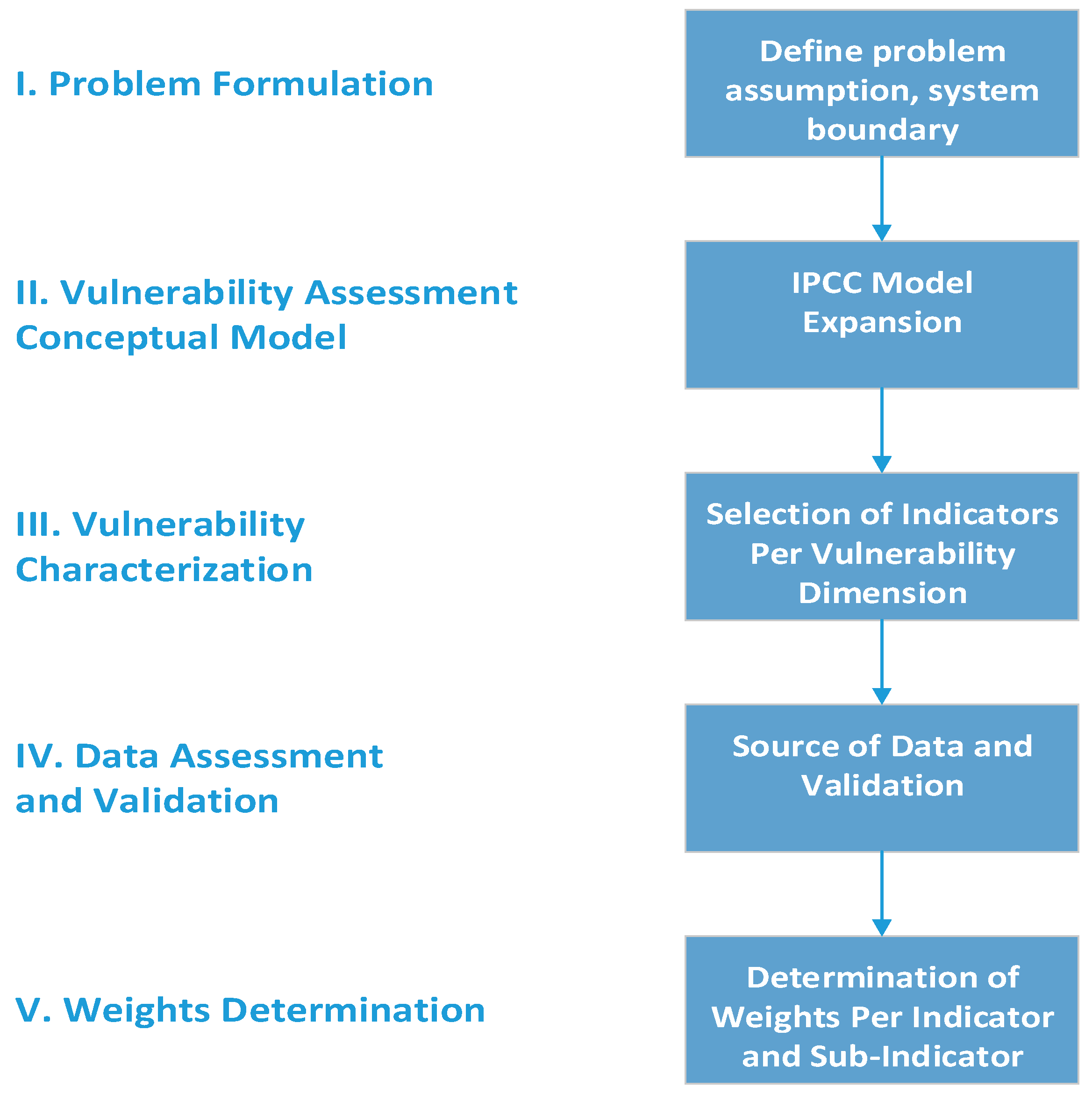
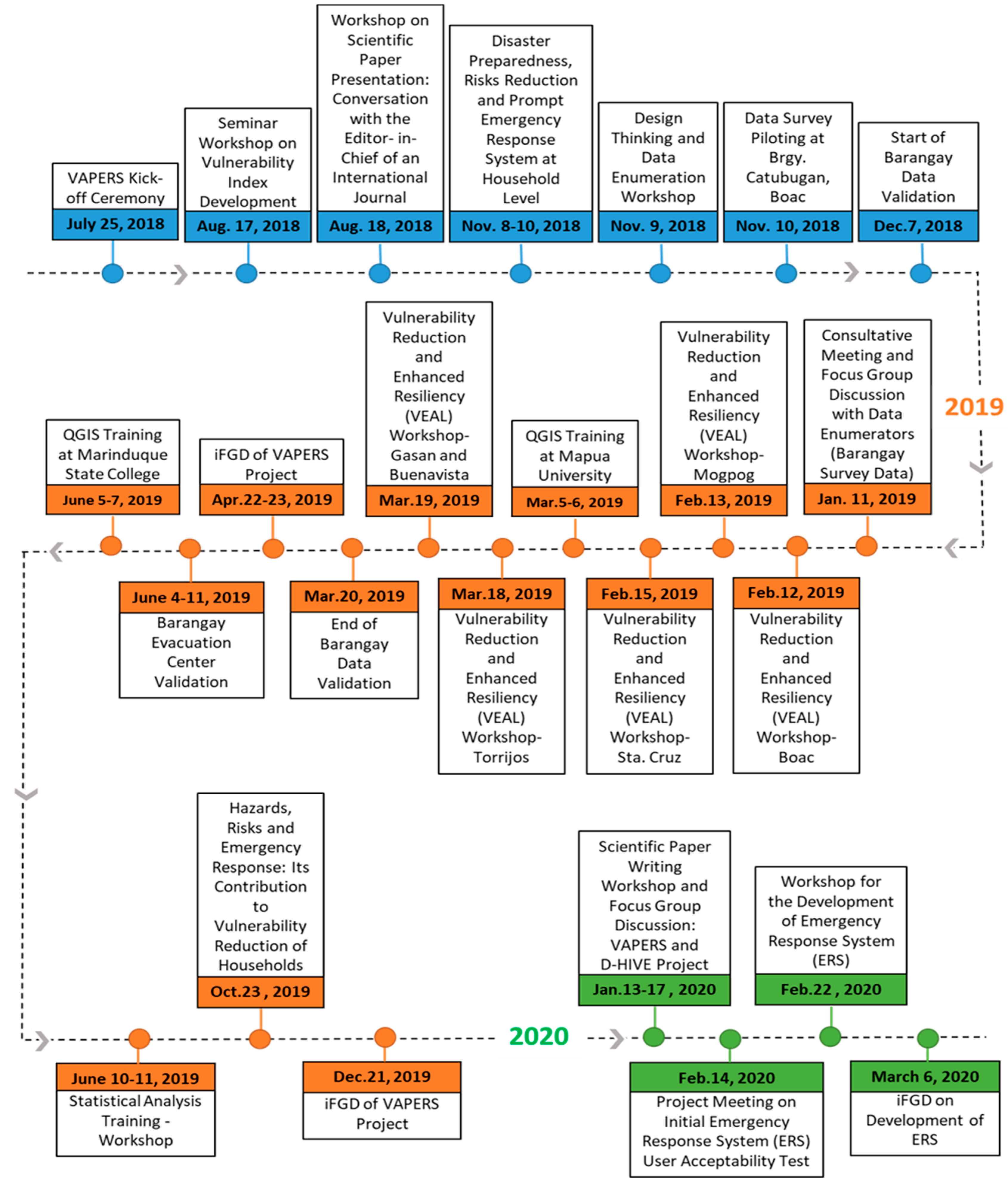
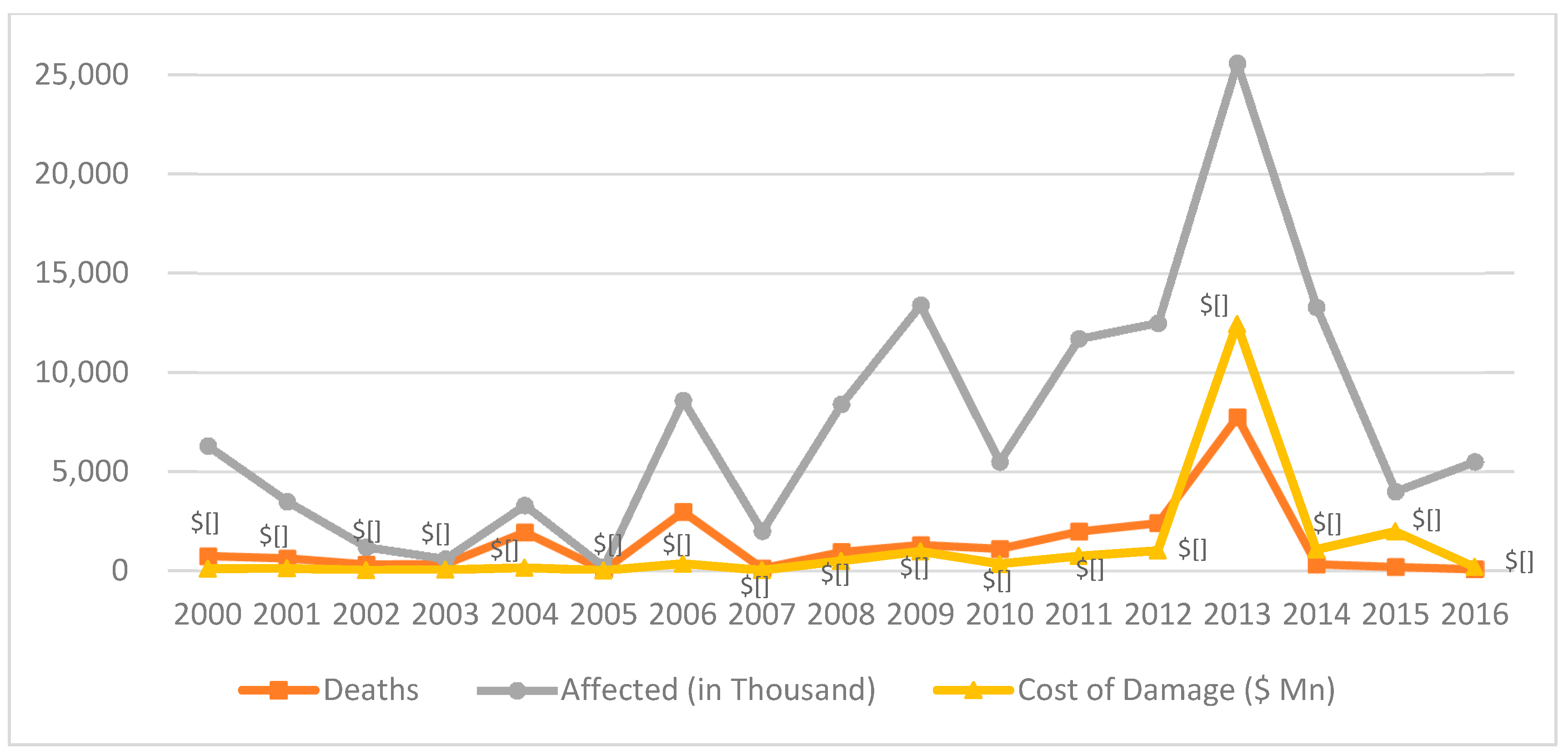
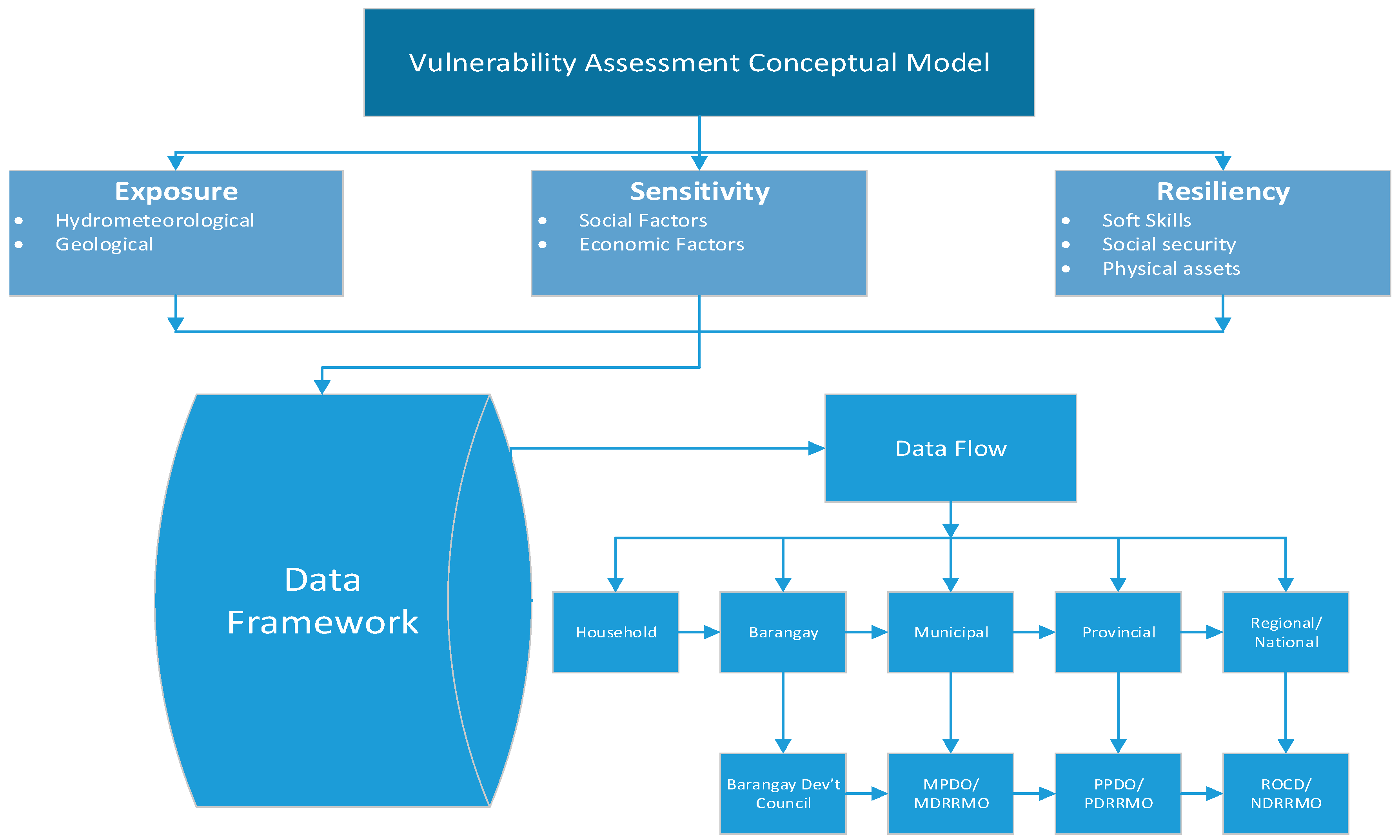

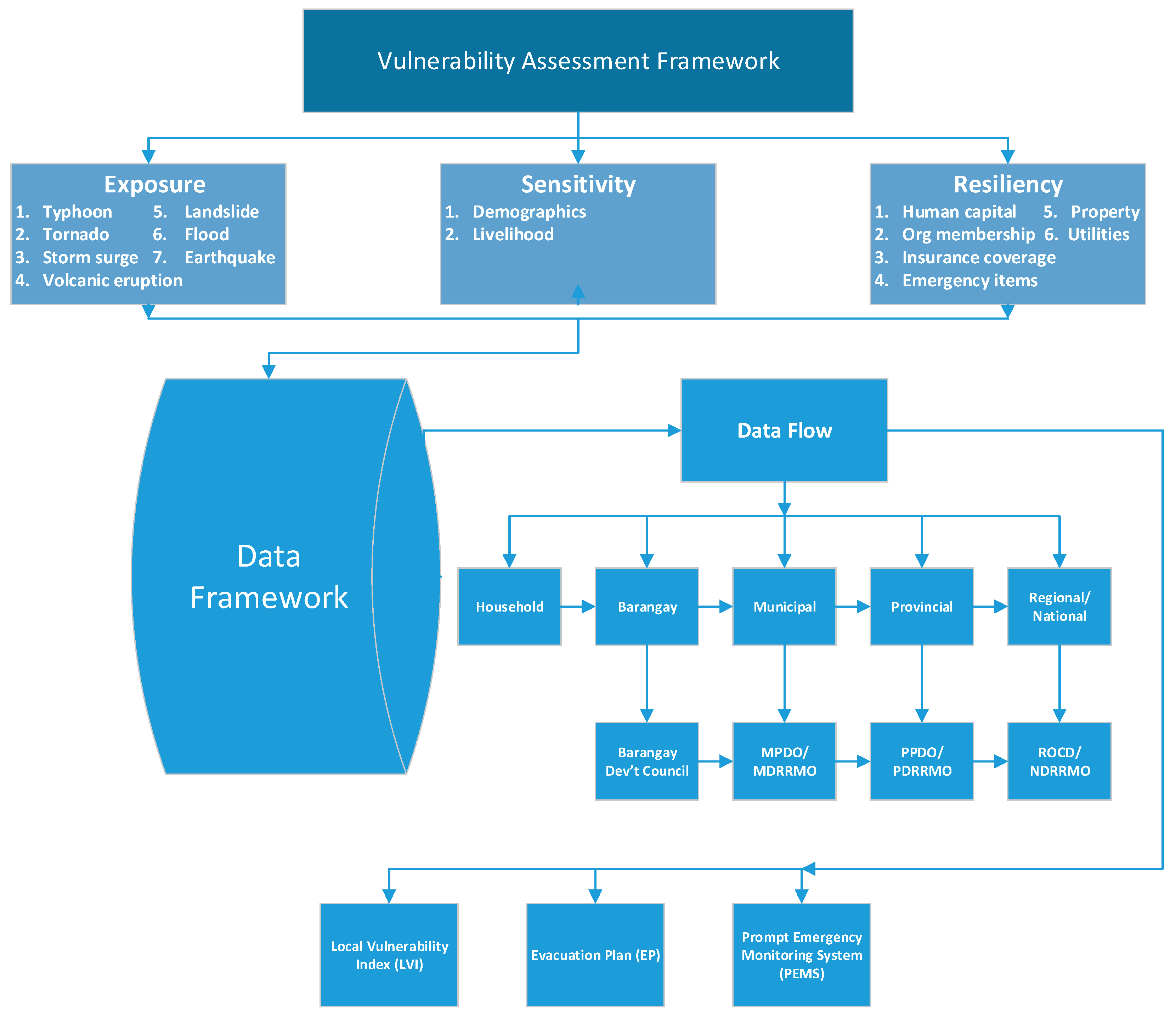
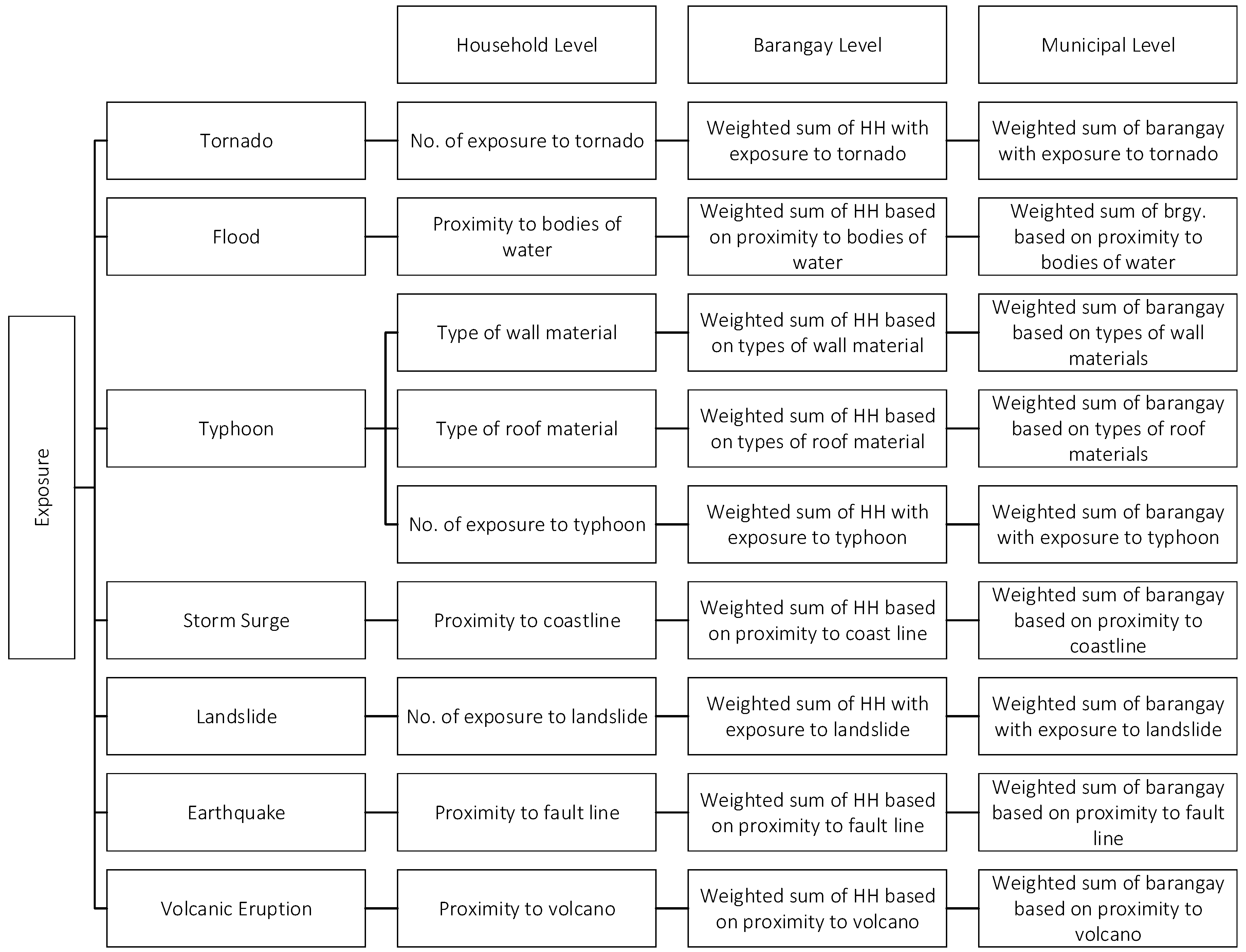
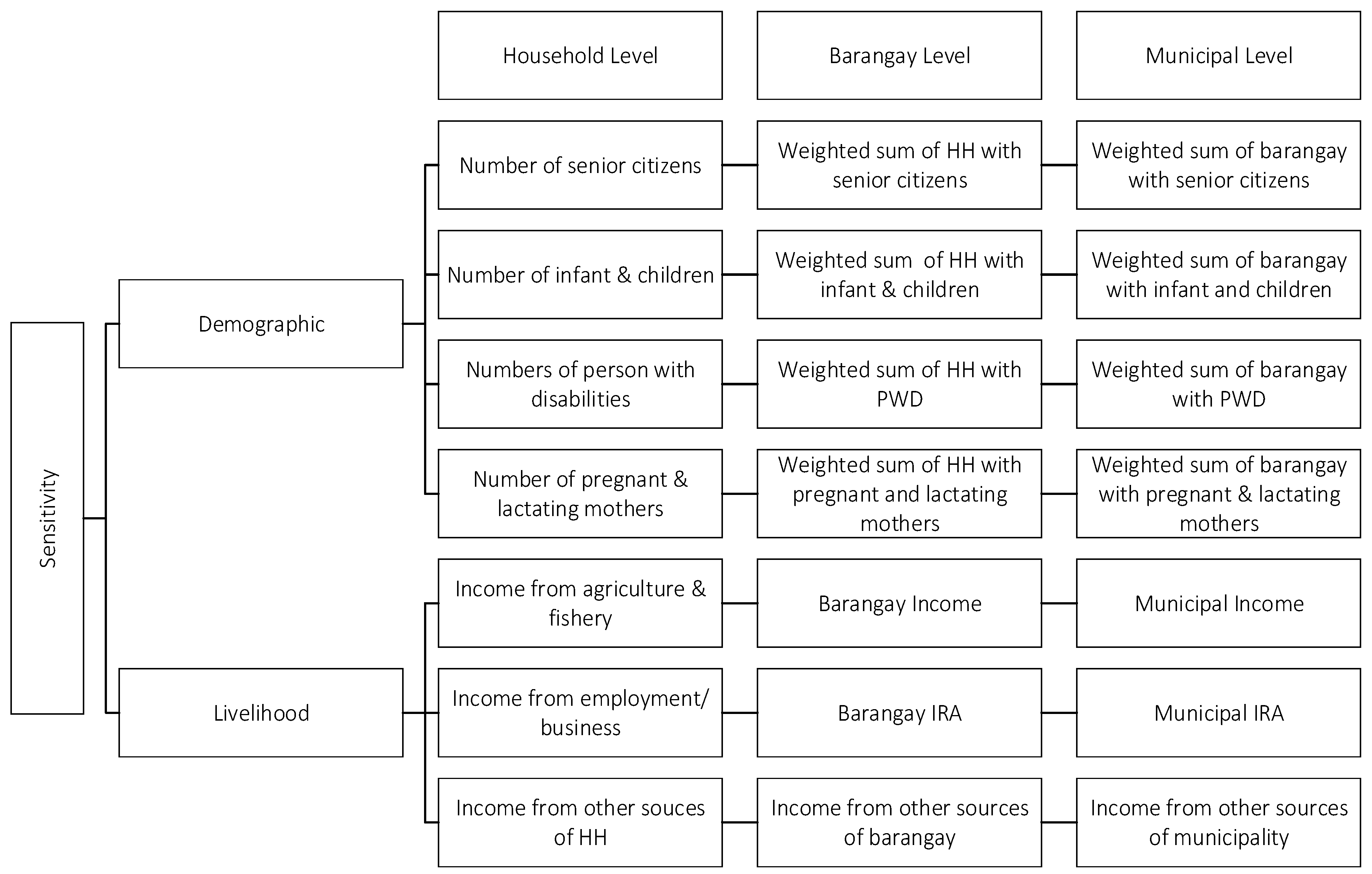
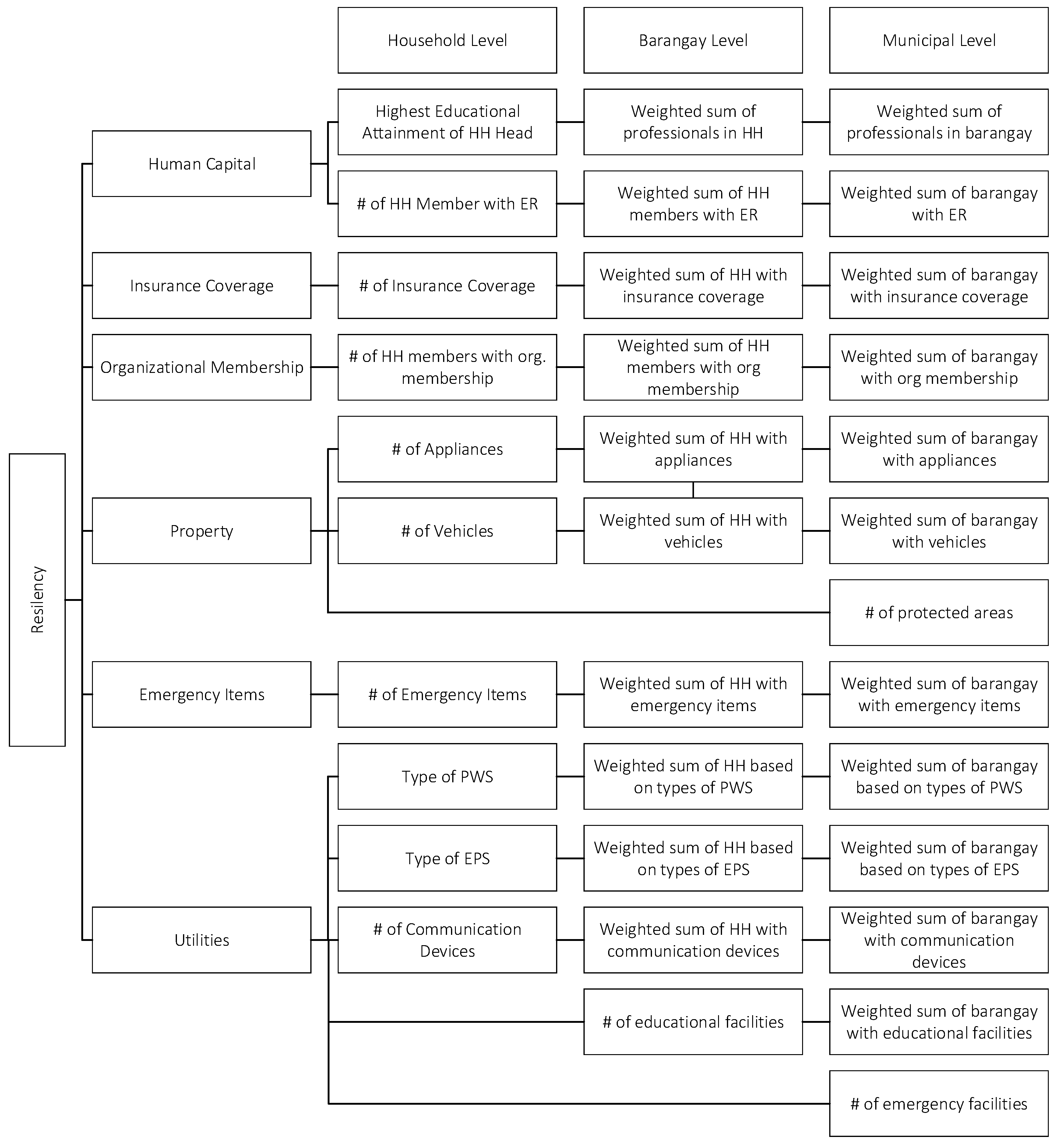

| Author | Exposure | Geo-Political Level | |||||||||
|---|---|---|---|---|---|---|---|---|---|---|---|
| Typhoon | Tornado | Storm Surge | Flood | Landslide | Earthquake | Volcanic Eruption | Drought | Household | Barangay | Municipal/Regional | |
| [8] | √ | √ | |||||||||
| [36] | √ | √ | √ | √ | |||||||
| [37] | √ | √ | √ | ||||||||
| [38] | √ | √ | √ | √ | |||||||
| [39] | √ | √ | √ | ||||||||
| [40] | √ | √ | |||||||||
| [41] | √ | √ | √ | √ | |||||||
| [42] | √ | √ | √ | √ | √ | √ | |||||
| [43] | √ | √ | √ | ||||||||
| [44] | √ | √ | |||||||||
| [45] | √ | √ | |||||||||
| [46] | √ | √ | √ | √ | √ | √ | |||||
| [47] | √ | √ | |||||||||
| [48] | √ | √ | |||||||||
| [49] | √ | √ | √ | ||||||||
| [50] | √ | √ | |||||||||
| [51] | √ | √ | |||||||||
| [52] | √ | √ | |||||||||
| [53] | √ | √ | √ | ||||||||
| [54] | √ | √ | √ | ||||||||
| [55] | √ | √ | |||||||||
| [56] | √ | ||||||||||
| [57] | √ | √ | |||||||||
| [58] | √ | √ | √ | √ | √ | ||||||
| [59] | √ | √ | √ | ||||||||
| [60] | √ | √ | |||||||||
| [61] | √ | √ | |||||||||
| [62] | √ | √ | √ | √ | √ | ||||||
| Questionnaire Template | |||
|---|---|---|---|
| Dimensions of Vulnerability | Degree of Contribution to Vulnerability | ||
| High (5) | Moderate (3) | Low (1) | |
| Exposure | |||
| Sensitivity | |||
| Resiliency | |||
| Exposure Indicators | Degree of Contribution to Exposure | ||
| High (5) | Moderate (3) | Low (1) | |
| 1. Typhoon | |||
| 2. Tornado | |||
| 3. Storm Surge | |||
| 4. Flood | |||
| 5. Landslide | |||
| 6. Earthquake | |||
| 7. Volcanic Eruption | |||
| Sensitivity Indicators | Degree of Contribution to Sensitivity | ||
| High (5) | Moderate (3) | Low (1) | |
| 1. Demographic | |||
| 2. Livelihood | |||
| Resiliency Indicators | Degree of Contribution to Resiliency | ||
| High (5) | Moderate (3) | Low (1) | |
| 1. Human Capital | |||
| 2. Org Membership | |||
| 3. Utilities | |||
| 4. Emergency Kit | |||
| 5. Insurance Coverage | |||
| 6. Property | |||
| Indicator | High (H) | Moderate (M) | Minor (N) | Total Score | Weights | |
|---|---|---|---|---|---|---|
| Exposure | E1 | E2 | E3 | [(E1*H) + (E2*M) + (E3*N)] | [1] | [1]/{[1] + [2] + [3]} |
| Sensitivity | S1 | S2 | S3 | [(S1*H) + (S2*M) + (S3*N)] | [2] | [2]/{[1] + [2] + [3]} |
| Resiliency | R1 | R2 | R3 | [(R1*H) + (R2*M) + (R3*N)] | [3] | [3]/{[1] + [2] + [3]} |
| Questionnaire Template | |||||||
|---|---|---|---|---|---|---|---|
| Sensitivity | |||||||
| Variable | Indicators | Variable | Household | Variable | Barangay | Variable | Municipality |
| Sa | Demographic | S1 | No. of Senior Citizen | S1.1 | Weighted mean of HH w/senior citizen | S1.2 | Weighted mean of HH in brgys w/senior citizen |
| S2 | No. of PWD | S2.1 | Weighted mean of HH w/PWD | S2.2 | Weighted mean of HH in brgys with PWD | ||
| S3 | No. of pregnant & lactating mothers | S3.1 | Weighted mean of HH w/pregnant & lactating mothers | S3.2 | Weighted mean of HH in brgys with pregnant & lactating mothers | ||
| S4 | No. of infant & children | S4.1 | Weighted mean of HH w/infant and children | S4.2 | Weighted mean of HH in brgys w/infant nd children | ||
| Sb | Livelihood | S5 | Income from employment/business | S5.1 | Barangay income | S5.2 | Municipal income |
| S6 | Income from agriculture, fishery | S6.1 | Barangay IRA | S6.2 | Municipal IRA | ||
| S7 | Income from other sources of HH | S7.1 | Income from other sources of barangay | S7.2 | Income from other sources of municipality | ||
| Exposure | |||||||
| Ea | Typhoon | E1 | Type of wall material | E1.1 | Weighted mean of HH based on type of wall material | E1.2 | Weighted mean of brgys based on type of wall material |
| E2 | Type of roof material | E2.1 | Weighted mean of HH based on roof material | E2.2 | Weighted mean of brgys based on roof material | ||
| E3 | No. of exposure to typhoon | E3.1 | Weighted mean of HH w/exposure to typhoon | E3.2 | Weighted mean of brgys w/exposure to typhoon | ||
| Eb | Tornado | E4 | No. of exposure to tornado | E4.1 | Weighted mean of HH w/exposure to tornado | E4.2 | Weighted mean of brgys w/exposure to tornado |
| Ec | Storm Surge | E5 | Proximity to coastline | E5.1 | Weighted mean of HH based on proximity to bodies of water | E5.2 | Weighted mean of brgys based on proximity to bodies of water |
| Ed | Flood | E6 | Proximity to bodies of water | E6.1 | Weighted mean of HH based on proximity to coastline | E6.2 | Weighted mean of brgy based on proximity to coastline |
| Ef | Landslide | E7 | No. exposure to landslide | E7.1 | Weighted mean of HH w/exposure to landslide | E7.2 | Weighted mean of brgys w/exposure to landslide |
| Eg | Earthquake | E8 | Proximity to fault line | E8.1 | Weighted mean of HH based on proximity to fault line | E8.2 | Weighted mean of brgys based on proximity to fault line |
| Eh | Volcano | E9 | Proximity to volcano | E.91 | Weighted mean of HH based on proximity to volcano | E9.2 | Weighted mean of brgys based on proximity to volcano |
| Resilience | |||||||
| Ra | Property | R1 | No. of appliances | R1.1 | Weighted mean of HH w/appliances | R1.2 | Weighted mean of brgys w/appliances |
| R2 | No. of vehicles | R.2.1 | Weighted mean of HH w/vehicles | R2.2 | Weighted mean of brgys w/vehicle | ||
| R13.2 | No. of protected areas | ||||||
| Rb | Insurance Coverage | R3 | No. of insurance coverage | R3.1 | Weighted mean of HH w/insurance coverages | R3.2 | Weighted mean of brgys w/insurance coverages |
| Rc | Emergency Kit | R4 | No. emergency items | R4.1 | Weighted mean of HH w/emergency items | R4.2 | Weighted mean of brgys w/emergency items |
| Rd | Utilities | R5 | Types of potable water sources (PWS) | R5.1 | Weighted mean of HH based on types of PWS | R5.2 | Weighted mean of brgys based on types of PWS |
| R6 | No. of communication devices | R6.1 | Weighted mean of HH w/communication devices | R6.2 | Weighted mean of brgys w/communication devices | ||
| R7 | Type of emergency power supply system (EPS) | R7.1 | Weighted mean of HH based on types of EPS | R7.2 | Weighted mean of brgys based on types of EPS | ||
| R11.1 | No. pf educational facilities | R11.2 | Weighted mean of brgys w/educational facilities | ||||
| R12.2 | No. of emergency facilities | ||||||
| Re | Organization Membership | R8 | No. of HH members w/organizational membership | R8.1 | Weighted mean of HH members with organizational membership | R8.2 | Weighted mean of brgys w/organizational membership |
| Basic Needs | No. | Indicators |
|---|---|---|
| Health | 1 | Proportion of children under 5 years who died |
| 2 | Proportion of women deaths due to pregnancy-related causes | |
| Nutrition | 3 | Proportion of children 0–5 years old who are malnourished |
| Housing | 4 | Proportion of households living in makeshift housing |
| 5 | Proportion of households who are informal settlers | |
| Water and Sanitation | 6 | Proportion of households without access to safe water supply |
| 7 | Proportion of households without access to sanitary toilet facilities | |
| Basic Education | 8 | Proportion of children 6–11 years old who are not in elementary school |
| 9 | Proportion of children 12–15 years old who are not in secondary school | |
| Income | 10 | Proportion of households with income below the poverty thresholds |
| 11 | Proportion of households with income below the food threshold | |
| 12 | Proportion of households that experienced hunger due to food shortage | |
| Employment | 13 | Proportion of persons who are unemployed |
| Peace and Order | 14 | Proportions of persons who were victims of crime |
| Type of Wall/Roof Building Materials | Weight |
|---|---|
| Made out of Strong Materials | 1 |
| Made out of Mix but predominantly strong materials | 2 |
| Made out of Light Materials | 3 |
| Made out of Mixed but predominantly light materials | 4 |
| Made out of Mixed but predominantly salvaged materials | 5 |
| Made out of Salvaged/Makeshift Materials | 6 |
| No Permanent Roof/No Roof at All | 7 |
| Questionnaire Template | ||||||||
|---|---|---|---|---|---|---|---|---|
| Sensitivity (33.35) | ||||||||
| Variable | INDICATORS | Weight | HH | Weight | Barangay | Weight | Municipal | Weight |
| Sa | Demographic | 0.1507 | S1 | 0.0167 | S1.1 | 0.0167 | S1.2 | 0.0167 |
| S2 | 0.0502 | S2.1 | 0.0502 | S2.2 | 0.0502 | |||
| S3 | 0.0419 | S3.1 | 0.0419 | S3.2 | 0.0419 | |||
| S4 | 0.0419 | S4.1 | 0.0419 | S4.2 | 0.0419 | |||
| Sb | Livelihood | 0.1829 | S5 | 0.0610 | S5.1 | 0.0610 | S5.2 | 0.0914 |
| S6 | 0.0610 | S6.1 | 0.0610 | S6.2 | 0.0914 | |||
| S7 | 0.0610 | S7.1 | 0.0610 | S7.2 | NA | |||
| Exposure (35.19) | ||||||||
| Ea | Typhoon | 0.1274 | E1 | 0.0425 | E1.1 | 0.0425 | E1.2 | 0.0425 |
| E2 | 0.0708 | E2.1 | 0.0708 | E2.2 | 0.0708 | |||
| E3 | 0.0142 | E3.1 | 0.0142 | E3.2 | 0.0142 | |||
| Eb | Tornado | NA | E4 | NA | E4.1 | NA | E4.2 | NA |
| Ec | Storm Surge | NA | E5 | NA | E5.1 | NA | E5.2 | NA |
| Ed | Flood | 0.0768 | E6 | 0.0768 | E6.1 | 0.0768 | E6.2 | 0.0768 |
| Ee | Landslide | 0.0671 | E7 | 0.0671 | E7.1 | 0.0671 | E7.2 | 0.0671 |
| Ef | Earthquake | 0.0588 | E8 | 0.0588 | E8.1 | 0.0588 | E8.2 | 0.0588 |
| Eg | Volcano | 0.0218 | E9 | 0.0218 | E9.1 | 0.0218 | E9.2 | 0.0218 |
| Resilience (31.46) | ||||||||
| Ra | Property | 0.0553 | R1 | 0.0092 | R1.1 | 0.0092 | R1.2 | 0.0207 |
| R2 | 0.0461 | R2.1 | 0.0461 | R2.2 | 0.0207 | |||
| R13.2 | 0.0138 | |||||||
| Rb | Insurance Coverage | 0.0493 | R3 | 0.0493 | R3.1 | 0.0493 | R3.2 | 0.0493 |
| Rc | Emergency Kit | 0.0521 | R4 | 0.0521 | R4.1 | 0.0521 | R4.2 | 0.0521 |
| Rd | Utilities | 0.0494 | R5 | 0.0275 | R5.1 | 0.0110 | R5.2 | 0.0092 |
| R6 | 0.0055 | R6.1 | 0.0055 | R6.1 | 0.0092 | |||
| R7 | 0.0165 | R7.1 | 0.0165 | R7.2 | 0.0092 | |||
| R11.1 | 0.0165 | R11.2 | 0.0165 | |||||
| R12.2 | 0.0055 | |||||||
| Re | Organization Membership | 0.0536 | R8 | 0.0536 | R8.1 | 0.0536 | R8.2 | 0.0536 |
| Rf | Human Capital | 0.0548 | R9 | 0.0137 | R9.1 | 0.0137 | R9.2 | 0.0137 |
| R10 | 0.0411 | R10.1 | 0.0411 | R10.2 | 0.0411 | |||
Publisher’s Note: MDPI stays neutral with regard to jurisdictional claims in published maps and institutional affiliations. |
© 2020 by the authors. Licensee MDPI, Basel, Switzerland. This article is an open access article distributed under the terms and conditions of the Creative Commons Attribution (CC BY) license (http://creativecommons.org/licenses/by/4.0/).
Share and Cite
Robielos, R.A.C.; Lin, C.J.; Senoro, D.B.; Ney, F.P. Development of Vulnerability Assessment Framework for Disaster Risk Reduction at Three Levels of Geopolitical Units in the Philippines. Sustainability 2020, 12, 8815. https://doi.org/10.3390/su12218815
Robielos RAC, Lin CJ, Senoro DB, Ney FP. Development of Vulnerability Assessment Framework for Disaster Risk Reduction at Three Levels of Geopolitical Units in the Philippines. Sustainability. 2020; 12(21):8815. https://doi.org/10.3390/su12218815
Chicago/Turabian StyleRobielos, Rex Aurelius C., Chiuhsiang Joe Lin, Delia B. Senoro, and Froilan P. Ney. 2020. "Development of Vulnerability Assessment Framework for Disaster Risk Reduction at Three Levels of Geopolitical Units in the Philippines" Sustainability 12, no. 21: 8815. https://doi.org/10.3390/su12218815
APA StyleRobielos, R. A. C., Lin, C. J., Senoro, D. B., & Ney, F. P. (2020). Development of Vulnerability Assessment Framework for Disaster Risk Reduction at Three Levels of Geopolitical Units in the Philippines. Sustainability, 12(21), 8815. https://doi.org/10.3390/su12218815






